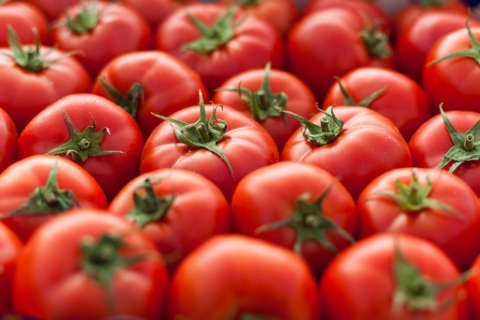Meet Mike in Reston this Sunday. Mike will give two garden talks (at 1 and 3 p.m.) at the Reston Town Center Garden Event on Sunday.
Tomatoes? ‘Tum, Tu, Tum, Tum’
Jack Straw in Walkersville, Maryland, writes: “I have a bottle of expired Tums. Can I crush them up and add them to my tomato plantings in a few weeks to boost the calcium?”
Yes, you can Jack. Tums are calcium carbonate plus flavors and colorings — none of which are a danger to your plants.
And any kind of crushed-up calcium carbonate will provide the kind of calcium you need to protect your fruits from blossom end rot — when tomatoes that are just turning ripe start to rot out on the bottom and turn black. And this is a fabulous use for expired pills! Whether you use eggshells, Tums or regular old calcium carbonate pills, crush them up well and drop them down the hole onto the top of the tomato’s root ball before you fill the hole back up.
Tomato planting 101
This is the earliest in the season that I have ever suggested in my 20 years on WTOP that it is safe to plant tomatoes, peppers and eggplants in the ground. So let’s make sure those tomatoes get planted correctly.
- Dig a deep hole.
- Pull off the leaves on the bottom half of the plant.
- Plop it in the hole so that at least one-half of the stem will be buried underground.
- Then add calcium to prevent blossom end rot: a dozen crushed eggshells, a dozen crushed calcium carbonate tablets or a half- cup of a calcium-rich organic plant food specifically designed for tomatoes.
- Fill the hole back up with the same soil you removed. Do not improve the soil in the hole.
- But do spread 2 inches of compost — not composted manure — as a nourishing and protective mulch around the base of the plant.
Hooray! Flower Mart is Back!
I just found out that one of my favorite local events opened on Friday and continues until 5 p.m. Saturday — Flower Mart at the National Cathedral.
It is a great family outing — lots of plants and tools and such for sale; food, music and at least two opportunities that, like Brigadoon, only happen once a year:
- For a fee, you can walk up 300 steps to the bell tower and get a breathtaking view of the area.
- It’s also the only time you can ride the cathedral’s antique carousel, which dates back to the 1890s.
And this year’s Flower Mart theme is all about pollinators, with pollinator-friendly plants for sale as well as details on how to attract all-important native bees to your property! Best of all, it’s free to walk around and just enjoy the buzz!
Corn gluten is also a fine fertilizer
Cynthia in Chevy Chase, Maryland, writes: “Have I missed the window to apply corn gluten meal to my lawn this spring? Should I apply it in the fall as well? If so, what’s the timing for a fall application?”
It is too late for any pre-emergent to prevent dormant weed seeds from sprouting, Cyn — but it’s the perfect time to give your lawn a gentle spring feeding — whether it’s a cool season lawn like bluegrass or fescue or a warm-season turf like Bermuda or zoysia that’s just now greening up.
And corn gluten meal is a perfect slow-release fertilizer that meets all the requirements of Maryland and Virginia’s lawn care laws.
And yes, if you have a cool-season lawn, you should feed it in the fall. In fact, that’s the most important feeding of the year. The perfect time is in late summer, right after the last heat wave breaks.
(Note: Warm season grasses should be fed in spring and summer; never fall.)
Throwing shade on a dogwood
Ray in Walkersville writes: “How do I help a dogwood that only has flowers on about 25% of the tree? (Otherwise, the tree is nicely leafed out and healthy.)”
I asked Ray if the soil drains well. Yes, he said.
How long has it been in the ground? About 12 years, he said.
And the big one: How much sun does it get and at what time of day? Ray’s response: “Afternoon to late-day sun.”
Bingo! Dogwoods are beautiful and native but can be a bit finicky. For the best flowering show, they should receive full sun in the morning and then a little shady relief from around 2 or 3 p.m. and on.
Ray says that he now understands, but that the current situation is still fine; they love the look of the tree.
If you plant a new dogwood this spring, remember: morning sun and afternoon shade.








